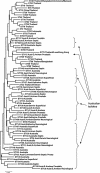Isolates of Burkholderia pseudomallei from Northern Australia are distinct by multilocus sequence typing, but strain types do not correlate with clinical presentation
- PMID: 15583269
- PMCID: PMC535284
- DOI: 10.1128/JCM.42.12.5477-5483.2004
Isolates of Burkholderia pseudomallei from Northern Australia are distinct by multilocus sequence typing, but strain types do not correlate with clinical presentation
Abstract
Melioidosis is the disease caused by the saprophytic organism Burkholderia pseudomallei. Previous studies have suggested some strain tropism and differential virulence. In this study, we defined strains by multilocus sequence typing (MLST) of isolates taken from the Top End of Australia's Northern Territory and compared the results with those of other strains typed worldwide. We specifically sought clinical and geographical correlates of strain types. Among 87 Australian isolates, 48 sequence types were defined. None of the sequence types in this study has been found elsewhere in the world. Strains were distributed widely throughout the region, and the different presentations of disease, including neurological and prostatic infection, were associated with many different strains. There was excellent congruence between pulsed-field gel electrophoresis and MLST, and the two typing methods had a similar level of strain discrimination. The work suggests that host and environmental factors may be more important in determining disease presentation than infecting strain type. It is possible that the distinct but diverse strain types found in this study reflect Australia's geographical isolation over many millions of years.
Figures



References
-
- American College of Chest Physicians/Society of Critical Care Medicine. 1992. American College of Chest Physicians/Society of Critical Care Medicine Consensus Conference: definitions for sepsis and organ failure and guidelines for the use of innovative therapies in sepsis. Crit. Care Med. 20:864-874. - PubMed
-
- Currie, B. J., D. A. Fisher, D. M. Howard, J. N. Burrow, D. Lo, S. Selva-Nayagam, N. M. Anstey, S. E. Huffam, P. L. Snelling, P. J. Marks, D. P. Stephens, G. D. Lum, S. P. Jacups, and V. L. Krause. 2000. Endemic melioidosis in tropical northern Australia: a 10-year prospective study and review of the literature. Clin. Infect. Dis. 31:981-986. - PubMed
-
- Dance, D. A., T. M. Davis, Y. Wattanagoon, W. Chaowagul, P. Saiphan, S. Looareesuwan, V. Wuthiekanun, and N. J. White. 1989. Acute suppurative parotitis caused by Pseudomonas pseudomallei in children. J. Infect. Dis. 159:654-660. - PubMed
Publication types
MeSH terms
Substances
LinkOut - more resources
Full Text Sources

